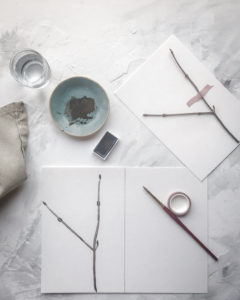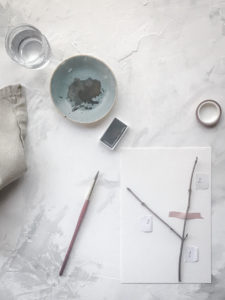Form I Brush Drawing Lesson
© 2019 Richele Baburina
 Spring is the perfect time for beginning brush drawing since branches are still bare. The model shown here is from a willow tree, but you can use a branch from whichever type of tree you have available. Feel free to remove some stems to make it simpler for beginners. Here are the steps to lead your children in painting an object from nature:
Spring is the perfect time for beginning brush drawing since branches are still bare. The model shown here is from a willow tree, but you can use a branch from whichever type of tree you have available. Feel free to remove some stems to make it simpler for beginners. Here are the steps to lead your children in painting an object from nature:
1) Tape your specimen to a piece of paper the same color as the paper you’ll be painting on and place it upright on the table where everyone can see it clearly.
2) Give each student a piece of paper with a line drawn down the middle.
3) If your children are young, you may load the brushes in burnt umber or another color close to your model. No color mixing is necessary.
4) Ask your children if they know from which kind of tree the model came. If necessary, explain that the specimen comes from such and such a tree and point out its chief stem and how it is made not of one line but is composed of two lines.
5) Beginning at the bottom, you will draw the main stem with one stroke of the brush, then continue to the second part of the main stem while your students observe.
 6) The children, having observed the model as well as the teacher’s stroke, will now copy the first stroke on the left side of their paper. (Left-handed children might start on the right-hand side of the paper.) All should hold the brush in the proper pencil grip with the brush 90° to the paper with either only the little finger or no part of their hand touching the paper so to give freedom of movement.
6) The children, having observed the model as well as the teacher’s stroke, will now copy the first stroke on the left side of their paper. (Left-handed children might start on the right-hand side of the paper.) All should hold the brush in the proper pencil grip with the brush 90° to the paper with either only the little finger or no part of their hand touching the paper so to give freedom of movement.
7) Proceed to the second stroke with the children again following your example. Next, draw the next longest stem with your students copying.
8) When all stems have been drawn, from chiefest to smallest, the buds are ready to be added. This is done by laying the brush down on the paper then lifting up to make the form of a bud in each place on the branch where one appears.
9) Now that the children have been led through each step and all mystery to what is expected is gone, they should view their model anew and make another attempt on the right-hand side of the page with more surety.
This is a modified version of a lesson first given by Emeline Steinthal in The Parents’ Review vol. 4, pp. 221-222.